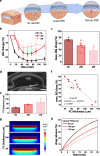Dynamic actuation enhances transport and extends therapeutic lifespan in an implantable drug delivery platform
- PMID: 35922421
- PMCID: PMC9349266
- DOI: 10.1038/s41467-022-32147-w
Dynamic actuation enhances transport and extends therapeutic lifespan in an implantable drug delivery platform
Abstract
Fibrous capsule (FC) formation, secondary to the foreign body response (FBR), impedes molecular transport and is detrimental to the long-term efficacy of implantable drug delivery devices, especially when tunable, temporal control is necessary. We report the development of an implantable mechanotherapeutic drug delivery platform to mitigate and overcome this host immune response using two distinct, yet synergistic soft robotic strategies. Firstly, daily intermittent actuation (cycling at 1 Hz for 5 minutes every 12 hours) preserves long-term, rapid delivery of a model drug (insulin) over 8 weeks of implantation, by mediating local immunomodulation of the cellular FBR and inducing multiphasic temporal FC changes. Secondly, actuation-mediated rapid release of therapy can enhance mass transport and therapeutic effect with tunable, temporal control. In a step towards clinical translation, we utilise a minimally invasive percutaneous approach to implant a scaled-up device in a human cadaveric model. Our soft actuatable platform has potential clinical utility for a variety of indications where transport is affected by fibrosis, such as the management of type 1 diabetes.
© 2022. The Author(s).
Conflict of interest statement
W.W., S.T.R., K.L.M., C.E.V., G.P.D., E.B.D., and E.T.R. are inventors on a pending patent application related to the device described here. The other authors declare no competing interests.
Figures






Similar articles
-
Intermittent actuation attenuates fibrotic behaviour of myofibroblasts.Acta Biomater. 2024 Jan 1;173:80-92. doi: 10.1016/j.actbio.2023.11.017. Epub 2023 Nov 14. Acta Biomater. 2024. PMID: 37967693
-
The Foreign Body Response to an Implantable Therapeutic Reservoir in a Diabetic Rodent Model.Tissue Eng Part C Methods. 2021 Oct;27(10):515-528. doi: 10.1089/ten.TEC.2021.0163. Tissue Eng Part C Methods. 2021. PMID: 34541880
-
Modulation of the foreign body response to implanted sensor models through device-based delivery of the tyrosine kinase inhibitor, masitinib.Biomaterials. 2013 Dec;34(38):9737-46. doi: 10.1016/j.biomaterials.2013.08.090. Epub 2013 Sep 20. Biomaterials. 2013. PMID: 24060424
-
Modulating the foreign body response of implants for diabetes treatment.Adv Drug Deliv Rev. 2021 Jul;174:87-113. doi: 10.1016/j.addr.2021.01.011. Epub 2021 Jan 21. Adv Drug Deliv Rev. 2021. PMID: 33484736 Free PMC article. Review.
-
Materials Strategies to Overcome the Foreign Body Response.Adv Healthc Mater. 2024 Jul;13(18):e2304478. doi: 10.1002/adhm.202304478. Epub 2024 May 2. Adv Healthc Mater. 2024. PMID: 38666550 Review.
Cited by
-
Predicting Blood Glucose Levels with Organic Neuromorphic Micro-Networks.Adv Sci (Weinh). 2024 Jul;11(27):e2308261. doi: 10.1002/advs.202308261. Epub 2024 Apr 29. Adv Sci (Weinh). 2024. PMID: 38682442 Free PMC article.
-
Wearable and Implantable Soft Robots.Chem Rev. 2024 Oct 23;124(20):11585-11636. doi: 10.1021/acs.chemrev.4c00513. Epub 2024 Oct 11. Chem Rev. 2024. PMID: 39392765 Free PMC article. Review.
-
The effect of the foreign body response on drug elution from subdermal delivery systems.Biomaterials. 2025 Jun;317:123110. doi: 10.1016/j.biomaterials.2025.123110. Epub 2025 Jan 13. Biomaterials. 2025. PMID: 39824001
-
Mechanoresponsive Drug Release from a Flexible, Tissue-Adherent, Hybrid Hydrogel Actuator.Adv Mater. 2024 Oct;36(43):e2303301. doi: 10.1002/adma.202303301. Epub 2023 Jul 19. Adv Mater. 2024. PMID: 37310046 Free PMC article.
-
Actuation-Mediated Compression of a Mechanoresponsive Hydrogel by Soft Robotics to Control Release of Therapeutic Proteins.Adv Sci (Weinh). 2025 Feb;12(7):e2401744. doi: 10.1002/advs.202401744. Epub 2024 Dec 18. Adv Sci (Weinh). 2025. PMID: 39692747 Free PMC article.
References
-
- Corradetti, B. The Immune Response to Implanted Materials and Devices: The Impact of the Immune System on the Success of an Implant. 10.1007/978-3-319-45433-7 (Springer International Publishing, 2016.)
Publication types
MeSH terms
Grants and funding
LinkOut - more resources
Full Text Sources

